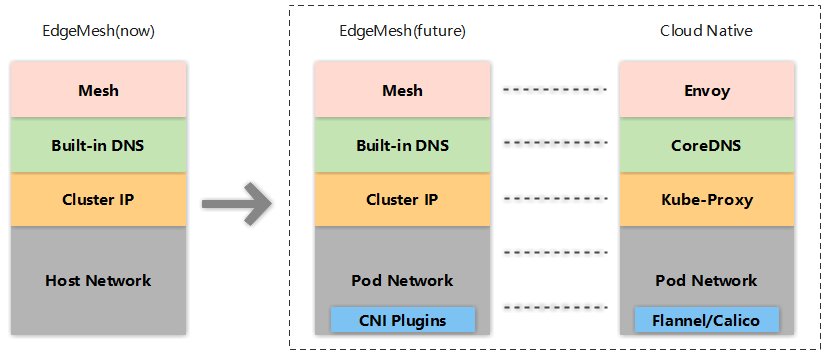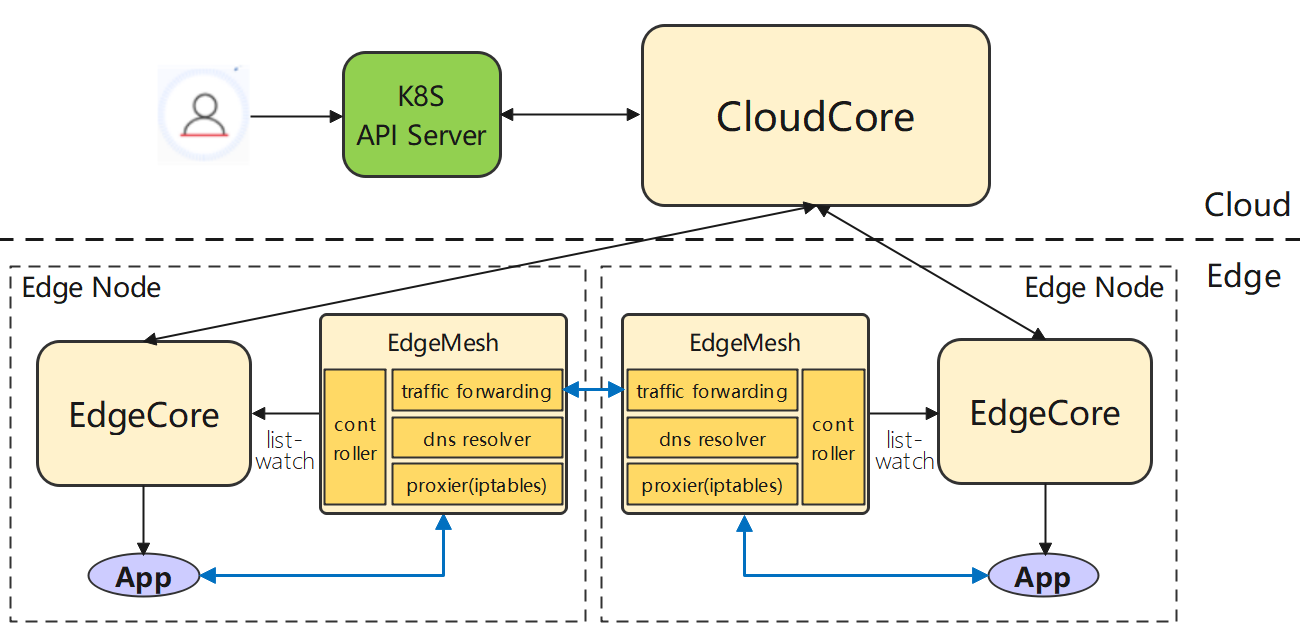The Overview of EdgeMesh
Introduction
EdgeMesh is a part of KubeEdge, and provides a simple network solution for the inter-communications between services at edge scenarios.
Background
KubeEdge is build based on Kubernetes, extending cloud-native containerized application orchestration capabilities to the edge. However, at the scenario of edge computer, the network topology is more complex. Edge nodes in different areas are offen not interconnected, and the inter-communication of traffic between applications is the primary requirement of the business. For this scenairo, EdgeMesh offers a solution.
Motivation
As the component of data panel on a KubeEdge cluster, EdgeMesh offers sample capacities (e.g, service discovery, traffic proxy, etc.) for applications running on the KubeEdge cluster, thus shielding the complex network topology at the edge scenairo.
Advantage
EdgeMesh satisfies the new requirements in edge scenarios (e.g., limited edge resources, unstable edge cloud network, etc.), that is, high availability, high reliability, and extreme lightweight:
- High availability
- Open up the network between edge nodes by using the edge cloud channel in KubeEdge
- Divide the communication between edge nodes into intra-LAN and cross-LAN
- Intra-LAN communication: direct access
- Cross-LAN communication: forwarding through the cloud
- High reliability (offline scenario)
- Both control plane and data plane traffic are delivered through the edge cloud channel
- EdgeMesh internally implements a lightweight DNS server, thus no longer accessing the cloud DNS
- Extreme lightweight
- Each node has one and only one EdgeMesh, which saves edge resources
User value
- For edge devices with limited resources, EdgeMesh provides a lightweight and highly integrated software with service discovery
- In the scene of Field Edge, compared to the mechanism of coredns + kube-proxy + cni service discovery , users only need to simply deploy an EdgeMesh to finish their goals
Key Features
| Feature | Sub-Feature | Realization Degree |
|---|---|---|
| Service Discovery | / | ✓ |
| Traffic Governance | HTTP | ✓ |
| TCP | ✓ | |
| Websocket | ✓ | |
| HTTPS | ✓ | |
| Load Balance | Random | ✓ |
| Round Robin | ✓ | |
| Session Persistence | ✓ | |
| External Access | / | ✓ |
| Multi-NIC Monitoring | / | ✓ |
| Cross-Subnet Communication | Cross-Cloud Communication | + |
| Cross-LAN E2E Communication | + | |
| Edge CNI | Cross-Subnet Pod Communication | + |
Noting:
✓Features supported by the EdgeMesh version+Features not available in the EdgeMesh version, but will be supported in subsequent versions-Features not available in the EdgeMesh version, or deprecated features
Future Works

At present, the implementation of EdgeMesh relies on the connectivity of the host network. In the future, EdgeMesh will realize the capabilities of CNI plug-ins, and realize the Pod network connectivity between edge nodes and nodes on the cloud, or edge nodes across LANs in a compatible manner with mainstream CNI plug-ins (e.g., flannel / calico, etc). Finally, EdgeMesh can even replace part of its own components with cloud-native components (e.g., replacing kube-proxy to achieve the capabilities of the Cluster IP, replacing node local dns cache to achieve node-level dns capabilities, and replace envoy to achieve mesh-layer capabilities).
Architecture

To ensure the capability of service discovery in some edge devices with low-version kernels or low-version iptables, EdgeMesh adopts the userspace mode in its implementation of the traffic proxy. In addition, it also comes with a lightweight DNS resolver. As shown in the figure above, the core components of EdgeMesh include:
- Proxier: Responsible for configuring the kernel’s iptables rules, and intercepting requests to the EdgeMesh process
- DNS: Built-in DNS resolver, which resolves the DNS request in the node into a service cluster IP
- Traffic: A traffic forwarding module based on the Go-chassis framework, which is responsible for forwarding traffic between applications
- Controller: Obtains metadata (e.g., Service, Endpoints, Pod, etc.) through the list-watch capability on the edge side of KubeEdge
How It Works
- Through the capability of list-watch on the edge of KubeEdge, EdgeMesh monitors the addition, deletion and modification of metadata (e.g., Services and Endpoints), and then creates iptables rules based on Services and Endpoints
- EdgeMesh uses the same ways (e.g., Cluster IP, domain name) as the K8s Service to access services
- When client’s requests accessing a service reach a node with EdgeMesh, it will enter the kernel’s iptables at first
- The iptables rules previously configured by EdgeMesh will redirect requests, and forward them all to the port 40001 which is occupied by the EdgeMesh process (data packets from kernel mode to user mode)
- After requests enter the EdgeMesh process, the EdgeMesh process completes the selection of backend Pods (load balancing occurs here), and then sends requests to the host where the Pod is located
Getting Started
Prerequisites
Before using EdgeMesh, you need to understand the following prerequisites at first:
- when using edgemesh’s capabilities, the Pod is required a hostPort (as shown in following examples)
- while using DestinationRule, the name of the DestinationRule must be equal to the name of the corresponding Service. Edgemesh will determine the DestinationRule in the same namespace according to the name of the Service
- Service ports must be named. The key/value pairs of port name must have the following syntax: name: <protocol>[-<suffix>]
Deployment
At the edge node, close EdgeMesh, open metaserver, and restart edgecore
1 | vim /etc/kubeedge/config/edgecore.yaml |
1 | systemctl restart edgecore |
On the cloud, open the dynamic controller module, and restart cloudcore
1 | vim /etc/kubeedge/config/cloudcore.yaml |
At the edge node, check if list-watch works
1 | curl 127.0.0.1:10550/api/v1/services |
Build EdgeMesh image (not necessary)
1 | docker build -t edgemesh:0.1 -f build/Dockerfile . |
Deploy EdgeMesh
1 | Please set the subNet to the value of service-cluster-ip-range of kube-apiserver. |
Test Case
HTTP
At the edge node, deploy a HTTP container application, and relevant service
1 | kubectl apply -f example/hostname.yaml |
Go to that edge node, use ‘curl’ to access the service, and print out the hostname of the container
1 | curl hostname-lb-svc.edgemesh-test:12345 |
TCP
At the edge node 1, deploy a TCP container application, and relevant service
1 | kubectl apply -f example/tcp-echo-service.yaml |
At the edge node 1, use ‘telnet’ to access the service
1 | telnet tcp-echo-service.edgemesh-test 2701 |
Websocket
At the edge node 1, deploy a websocket container application, and relevant service
1 | kubectl apply -f example/websocket-pod-svc.yaml |
Enter the container, and use ./client to access the service
1 | docker exec -it 2a6ae1a490ae bash |
Load Balance
The capability of load balance needs to add the CRD ‘DestinationRule’
1 | kubectl apply -f build/istio/destinationrule-crd.yaml |
Use the ‘loadBalancer’ in ‘DestinationRule’ to select LB modes
1 | vim example/hostname-lb-random.yaml |
EdgeMesh Ingress Gateway
EdgeMesh ingress gateway provides a ability to access services in external edge nodes.

HTTP Gateway
Create two CRDs: ‘Gateway’ and ‘VirtualService’
1 | kubectl apply -f build/istio/gateway-crd.yaml |
Deploy edgemesh-gateway
1 | kubectl apply -f 03-configmap.yaml |
Create ‘Gateway’ and ‘VirtualService’
1 | kubectl apply -f example/hostname-lb-random-gateway.yaml |
Check if the edgemesh-gateway is successfully deployed
1 | kubectl get gw -n edgemesh-test |
Finally, use the IP and the port exposed by the VirtualService to access
1 | curl 192.168.0.211:12345 |
HTTPS GateWay
Create a test key file
1 | $ openssl req -x509 -nodes -days 365 -newkey rsa:2048 -keyout tls.key -out tls.crt -subj "/CN=kubeedge.io" |
Create a ‘Secret’ according to the key file
1 | $ kubectl create secret tls gw-secret --key tls.key --cert tls.crt -n edgemesh-test |
Create a Secret-bound ‘Gateway’ and routing rules ‘VirtualService’
1 | $ kubectl apply -f example/hostname-lb-random-gateway-tls.yaml |
Finally, use the certificate for a HTTPS access
1 | $ curl -k --cert ./tls.crt --key ./tls.key https://192.168.0.129:12345 |
Reference
https://github.com/xiaoli777/edgemesh